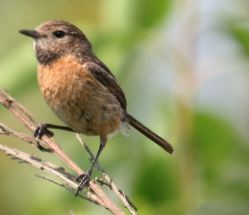SLIEVENACLOY looks serene in this picture Dúlra took on Sunday: a sparkling stream meandering across the hillside, not a soul to be seen across the wide green expanse in the background.
But this nature reserve above west Belfast is so elevated that it reminds Dúlra of the Arctic tundra. Up here winter lasts a few weeks longer than it does in the city. There mightn’t be any snow, but it’s as if the land still needs to thaw out.
On Sunday, it was as if nature was too afraid to show its hand. The early blast of spring sun was doing its best to coax it into life, but the countryside was wary. Once bitten, twice shy is nature’s maxim. A tree that takes a chance to allow its leaves to burst into life in the March sunshine will inevitably be punished, maybe not this year, but some year. A cold snap will eventually shrivel the buds and prove fatal to the whole tree. Nature won’t take a punt.
Everything is done like clockwork in a timetable developed over millennia that has weeded out all the weak and the stupid. And so on Sunday there wasn’t even the hint of a green bud on any of the wizened shrubs on Slievenacloy. The sun was blasting hot on Dúlra’s face, but as far as nature was concerned, up here it was still winter. Even if you don’t see anything exciting during a trip to the countryside, it’s never a waste. It’s like building up a map, with each visit laid on top of the previous one to eventually produce a full picture.
On Sunday, birder Geordie Hynes had his sights on something completely different: newts, earc luachra in Irish, the newt of the rushes; and there’s plenty of rushes around here for them to hide in. That’s Geordie with his newt net which he used to skim the bed of the stream. The search drew a blank – the newt is an elusive creature that Dúlra hasn’t come across in many years – and Slievnacloy is much more famous for its lizards, which hide in the grass.

The hillside here is just coming out of hibernation and won’t come into its own until the hordes of summer visitors arrive from Africa in a few weeks' time, like the sedge and grasshopper warblers and wheatears. Only the hardiest of birds live here in winter and they deserve our full admiration.
One such bird is the stonechat, caislín cloch in Irish. Geordie heard one before he spotted it darting from a fence post. We found a bit of cover and focused the bins. This bird, in this habitat, looks like it belongs in a watercolour painting, with its pastel orange and yellow plumage. It was a male, and before long the less striking female appeared from a low clump of bramble not far away. A small piece of straw was clearly visible in her beak – she was nest-building.
We had no intention of disturbing this beautiful partnership as they built their nest in the low undergrowth in the wild hilliside of Slievenacloy. But it was brilliant to know where they were nesting here. As the weeks and months go by, we can return and watch them from a distance. It seems, after all, that Slievenacloy has started to thaw.
• Wee Mac’s usefulness knows no bounds. This week the terrier helped Dúlra find a goldfinch’s nest – and it didn’t even have to lift a paw. As spring arrived, Mac got his biannual haircut and his wiry coat is always in demand, that’s why Dúlra left clumps of it on the lawn.
Dúlra retreated to the house, binoculars in hand, waiting to see if any birds would want it for their nests.
The local robins and dunnocks didn’t seem interested – maybe they like a softer lining than Mac’s course coat – but then a goldfinch dropped out of the sky and on to the lawn. It hopped up to the wool-like hair and grabbed a beakful.
The goldfinch is an expert at hiding its tiny nest and usually Dúlra only finds them in winter when all the foliage dies and you realise it was right in front of your eyes all along. And so Dúlra focused the binoculars on the beautiful bird with a clump of Mac’s hair in its gob. He followed it as it took to the air, crossing the road and dropping down into an ornamental fir tree in a neighbour’s garden. Bingo! Now he can keep an eye on the pair of neighbourhood goldfinches through the summer as they raise a family, it’s a rare treat to be able to keep close tabs on such spectacular bids. Mac deserves a bone!
If you’ve seen or photographed anything interesting, or have any nature questions, you can text Dúlra on 07801 414804.







